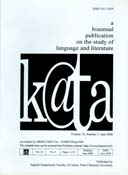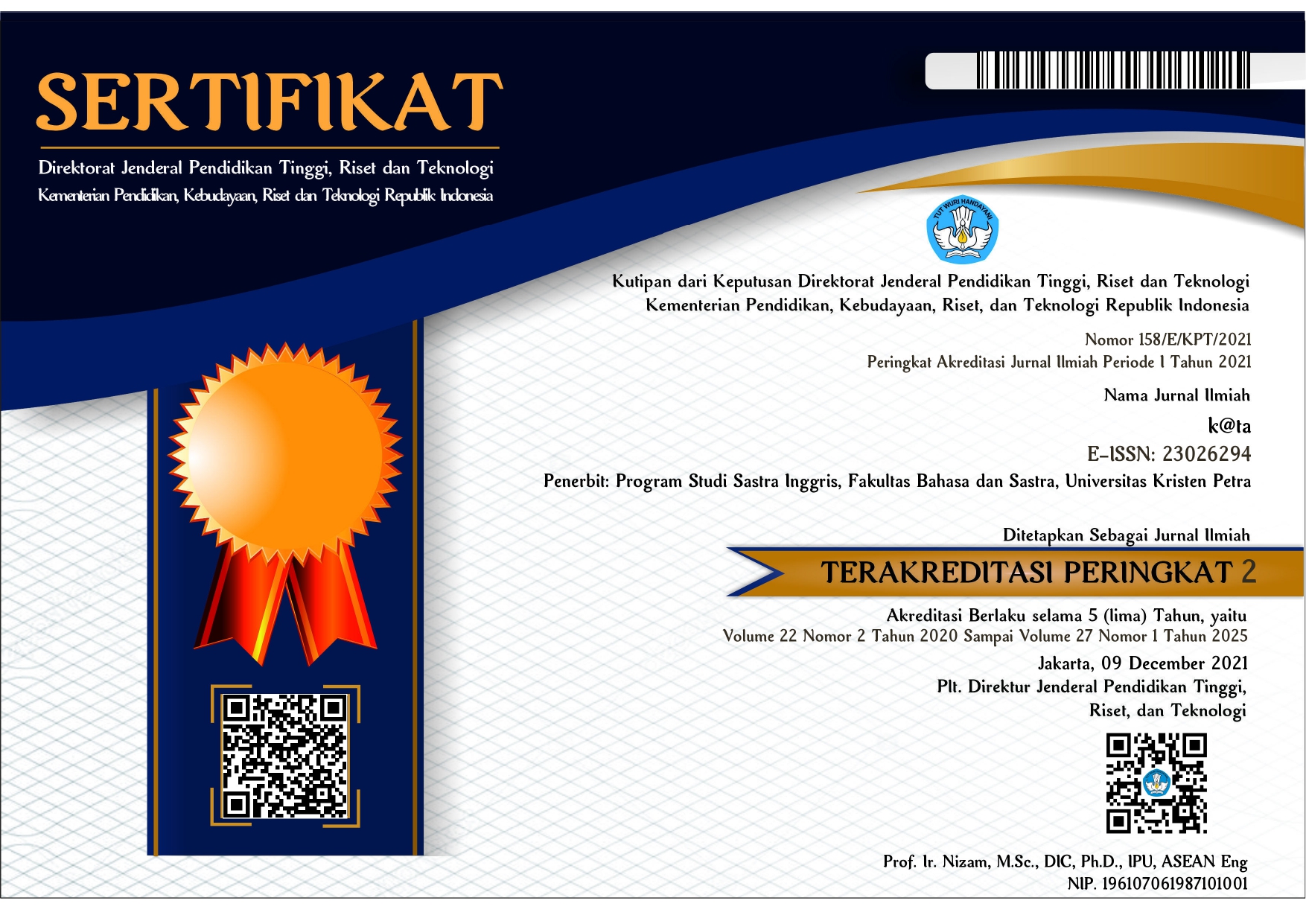People and Nature in Asian Stories: Reading and Writing Materials for Eco Education
Keywords:
Ecocriticism, traditional wisdom, anthropocentric views
Abstract
The purpose of this article is to make parents/teachers/writers of children literature aware of eco education through stories about people and nature. Written through the eyes of a child, many conservation stories not only empower the young minds, but they also help adults change their attitude to respect environment. The first part of this article examines such environmental stories as fables, folklores, short stories from Asia, while the second part is a project report on writing eco education materials, i.e. a serial of 3 environmental stories for young adults. Using Ecocriticism and Postcolonial perspectives to analyze the stories, the study shows that the narrative strands found in the stories include (1) depletion of the earth and natural resources, (2) people’s greediness, and (3) preservation of the traditional wisdom. Some stories are still anthroÂpocentric so as to provide no space to explore fully the human-nature relationship in a balanced way. Although animal stories dominate the narratives, it is the specific and philosophic depiction of place and nature that give the stories Asian characteristics in their shared campaign to save our planet. This study concludes that the call for environmental protection can be done through young adult literature in a non-condescending manner instead of the usual patronizing-colonizing methodDownloads
Download data is not yet available.
References
Ashcroft, B., Griffiths, G. & Tiffins, H. (1989). The empire writes back: Theory and practice in post-colonial literatures. London: Routledge.
Ashcroft, B. Postcolonial transformation. (2001). London: Routledge.
Bradford, C. (2007). Unsettling narratives: Post¬colonial readings of children’s literature. Canada: Wilfrid Laurier University Press.
Dewi, N. (2015). Manusia dan lingkungan dalam cerpen Indonesia kontemporer: Analisis eko¬kritik cerpen pilihan Kompas [People and environment in contemporary Indonesian short stories: Ecocritical analysis on Kompas selected short stories]. LITERA, 2 (14), 376– 391. http://journal.uny.ac.id/index.php/litera/article/ view/7211/6216
Donelson-Sims, D. E. (2013). Stuck in a moral prison: Exploring the roots of why Indonesian students moralize literature. k@ta: A Biannual Publication on the Study of Language & Literature, 15 (2), 101–108. DOI: 10.9744/ kata.15.2.101-108
Diharja, P., S. J. Menyambut mentari. Yogyakarta: Sanata Dharma University Press, 2016. ISBN 978-602-74881-3-7
Diharja, P., S. J. Kering kemarau. Yogyakarta: Sanata Dharma University Press, 2016. ISBN 978-602-74881-5-1
Diharja, P., S. J. Pesta menyambut hujan. Yogya¬karta: Sanata Dharma University Press, 2016. ISBN 978-602-74881-7-5
Ellis, Brian “Foxâ€. (2012). Learning from the land: Teaching ecology through stories and activi¬ties, 2nd Edition. Santa Barbara: ABC-CLIO, LLC.
Gaard, G. (2009). Children’s environmental literature: From ecocriticism to ecopedagogy. Neo¬helicon, 36 (2), 23–39. DOI: 10.1007/s11059-009-0003-7
Huggan, G & Tiffin, H. (2010). Postcolonial eco¬criticism: Literature, animals, environment. London: Routledge.
Lindenpütz, D. (2016, October). Children’s literature as a medium of environmental education. The culture of German environmentalism: Anxie¬ties, visions, realities. Ed. A. Goodbody, 187 – 202.
Livo, Norma J. (2003). Bringing out their best: Values education and character development through traditional tales. Westport, CT: Libraries Unlimited.
MacDonald, Margaret Read. (1999). Earth care: World folktales to talk about. Atlanta: August House Publisher.
_____. (2003). Cerita-cerita pelestarian lingkungan: Cerita rakyat dari berbagai penjuru dunia. Trsl. F. C. Wardani. Yogyakarta: Penerbit Kanisius.
Marzec, Robert P. (2007). An ecological and postcolonial study of literature: From Daniel Defoe to Salman Rushdie. New York: Palgrave Macmillan.
Massey, Geraldine. (2009). Reading the environment: Narrative constructions of ecological subject¬tivities in Australian children’s literature, Unpublished Ph.D Thesis, Queensland Uni¬ver¬sity of Technology.
Nodelman, Perry. (2008). The hidden adult: Defining children's literature. Baltimore: Johns Hopkins University Press.
O'Brien, Kathy, and Darleen K. Stoner. (1987). “Increasing environmental awareness through children's literature†The Reading Teacher, 41 (1), 14-19. Retrieved from http://www.jstor. org/stable/20199688.
Parkinson, Rob. (2009). Transforming tales: How stories can change people. London: Jessica Kingsley Publishers.
Pope Francis. (2015). Encyclical letter laudato si’ of the Holy Father Francis on care for our common home. Vatican City: Libreria Editrice Vaticana.
Ramos, Rui and Ana Margarida Ramos. (2015). Children’s literature and the promotion of environmental ethics in Portugal. Portuguese Studies, 31 (1), 94-106.
Strickland, Tessa. (2009, Spring). Stones, woods and water: Deep ecology and children’s literature. IBBYLink, 24, 6–8 Retrieved from https://www. google.co.id/?gws_rd=cr&ei=Ksf1V6_oHMXF0gTUpaOwBQ#q=children%27s+literature+and+ecocriticism+jstor
Tantri Novianti. (2014). Putri alor [Princess alor], Kompas Minggu, 7 September, 35.
Tyas K W. (2016). Menanam bakau [Planting mangrove], Kompas Minggu, 24 Juli, 19.
Wahyu Indriati. (2016), Warisan mbah Amat [The inheritance of mbah Amat], Kompas Minggu, 9 October, 10.
Ashcroft, B. Postcolonial transformation. (2001). London: Routledge.
Bradford, C. (2007). Unsettling narratives: Post¬colonial readings of children’s literature. Canada: Wilfrid Laurier University Press.
Dewi, N. (2015). Manusia dan lingkungan dalam cerpen Indonesia kontemporer: Analisis eko¬kritik cerpen pilihan Kompas [People and environment in contemporary Indonesian short stories: Ecocritical analysis on Kompas selected short stories]. LITERA, 2 (14), 376– 391. http://journal.uny.ac.id/index.php/litera/article/ view/7211/6216
Donelson-Sims, D. E. (2013). Stuck in a moral prison: Exploring the roots of why Indonesian students moralize literature. k@ta: A Biannual Publication on the Study of Language & Literature, 15 (2), 101–108. DOI: 10.9744/ kata.15.2.101-108
Diharja, P., S. J. Menyambut mentari. Yogyakarta: Sanata Dharma University Press, 2016. ISBN 978-602-74881-3-7
Diharja, P., S. J. Kering kemarau. Yogyakarta: Sanata Dharma University Press, 2016. ISBN 978-602-74881-5-1
Diharja, P., S. J. Pesta menyambut hujan. Yogya¬karta: Sanata Dharma University Press, 2016. ISBN 978-602-74881-7-5
Ellis, Brian “Foxâ€. (2012). Learning from the land: Teaching ecology through stories and activi¬ties, 2nd Edition. Santa Barbara: ABC-CLIO, LLC.
Gaard, G. (2009). Children’s environmental literature: From ecocriticism to ecopedagogy. Neo¬helicon, 36 (2), 23–39. DOI: 10.1007/s11059-009-0003-7
Huggan, G & Tiffin, H. (2010). Postcolonial eco¬criticism: Literature, animals, environment. London: Routledge.
Lindenpütz, D. (2016, October). Children’s literature as a medium of environmental education. The culture of German environmentalism: Anxie¬ties, visions, realities. Ed. A. Goodbody, 187 – 202.
Livo, Norma J. (2003). Bringing out their best: Values education and character development through traditional tales. Westport, CT: Libraries Unlimited.
MacDonald, Margaret Read. (1999). Earth care: World folktales to talk about. Atlanta: August House Publisher.
_____. (2003). Cerita-cerita pelestarian lingkungan: Cerita rakyat dari berbagai penjuru dunia. Trsl. F. C. Wardani. Yogyakarta: Penerbit Kanisius.
Marzec, Robert P. (2007). An ecological and postcolonial study of literature: From Daniel Defoe to Salman Rushdie. New York: Palgrave Macmillan.
Massey, Geraldine. (2009). Reading the environment: Narrative constructions of ecological subject¬tivities in Australian children’s literature, Unpublished Ph.D Thesis, Queensland Uni¬ver¬sity of Technology.
Nodelman, Perry. (2008). The hidden adult: Defining children's literature. Baltimore: Johns Hopkins University Press.
O'Brien, Kathy, and Darleen K. Stoner. (1987). “Increasing environmental awareness through children's literature†The Reading Teacher, 41 (1), 14-19. Retrieved from http://www.jstor. org/stable/20199688.
Parkinson, Rob. (2009). Transforming tales: How stories can change people. London: Jessica Kingsley Publishers.
Pope Francis. (2015). Encyclical letter laudato si’ of the Holy Father Francis on care for our common home. Vatican City: Libreria Editrice Vaticana.
Ramos, Rui and Ana Margarida Ramos. (2015). Children’s literature and the promotion of environmental ethics in Portugal. Portuguese Studies, 31 (1), 94-106.
Strickland, Tessa. (2009, Spring). Stones, woods and water: Deep ecology and children’s literature. IBBYLink, 24, 6–8 Retrieved from https://www. google.co.id/?gws_rd=cr&ei=Ksf1V6_oHMXF0gTUpaOwBQ#q=children%27s+literature+and+ecocriticism+jstor
Tantri Novianti. (2014). Putri alor [Princess alor], Kompas Minggu, 7 September, 35.
Tyas K W. (2016). Menanam bakau [Planting mangrove], Kompas Minggu, 24 Juli, 19.
Wahyu Indriati. (2016), Warisan mbah Amat [The inheritance of mbah Amat], Kompas Minggu, 9 October, 10.
Published
2017-06-01
How to Cite
Dewi, N. (2017). People and Nature in Asian Stories: Reading and Writing Materials for Eco Education. K@ta: A Biannual Publication on the Study of Languange and Literature, 19(1), 32-40. https://doi.org/https://doi.org/10.9744/kata.19.1.32-40
Section
Articles
![]() This work is licensed under a Creative Commons Attribution License
This work is licensed under a Creative Commons Attribution License




.png)
.png)

.png)












